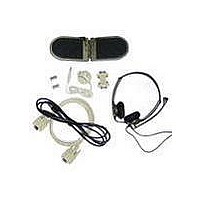AC300030 Microchip Technology, AC300030 Datasheet - Page 32

AC300030
Manufacturer Part Number
AC300030
Description
KIT ACOUSTIC ACCESSORY
Manufacturer
Microchip Technology
Specifications of AC300030
Accessory Type
Accessory Kit
Product
Audio Modules
Lead Free Status / RoHS Status
Lead free / RoHS Compliant
For Use With/related Products
Noise Suppression/Acoustic Echo Cancellation Library
Lead Free Status / Rohs Status
Lead free / RoHS Compliant
dsPIC
4.3
FIGURE 4-7:
DS70134E-page 32
R
S
OUT
IN
from speaker to
Acoustic path
microphone
AEC ALGORITHM OVERVIEW
DSC Acoustic Echo Cancellation Library User’s Guide
This section describes the Acoustic Echo Cancellation (AEC) algorithm. A conceptual
block diagram illustrating the operation of the AEC algorithm is shown in
AEC ALGORITHM FUNCTIONAL BLOCKS
The AEC algorithm can be divided into these functions:
• Normalized Least Mean Square (NLMS) Adaptive Filter
• Double Talk Detector (DTD)
• Nonlinear Processor (NLP)
• Howling Control
A typical AEC system involves these four signals:
• Far-end speech receive input (R
• Near-end speech send output (S
• Far-end speech output (R
• Near-end speech input (S
The systems in which the near-end speaker and microphone do not have sufficient
acoustic separation, the S
spoken by a talker at the near-end), but also an undesirable echo generated by the
acoustic path from the speaker to the microphone. This signal is then transmitted to the
far-end through the communication channel (wired or wireless), with the result that the
listener at the other end hears a perceptible echo of his/her own speech. Traditionally,
this problem was avoided by allowing only one person to talk at any given time (i.e., by
not allowing “double talk”).
An acoustic echo cancellation algorithm consists of an adaptive filter and various asso-
ciated control functions, which not only eliminate the acoustic echo but also enables
double talk (i.e., full-duplex operation). This algorithm operates at the same communi-
cating node at which the echo was generated. The control functions used in the AEC
algorithm, in conjunction with the NLMS adaptive filter, are Double Talk Detector,
Nonlinear Processor, and Howling Control.
Adaptive Filter
Least Mean
Normalized
(NLMS)
Square
IN
OUT
IN
signal not only contains the microphone input (presumably
), usually received from a local microphone
Processor
Nonlinear
), usually sent to a local speaker
(NLP)
IN
OUT
)
)
Howling Control
Double Talk
© 2011 Microchip Technology Inc.
Detector
(DTD)
Figure
S
R
OUT
IN
4-7.











